Your business cannot survive without using sales emails.
OK, I know what you are thinking.
You’re thinking, “He is so full of crap, his eyes are turning brown.”
Listen…
Over half of the world’s population uses the Internet, and 49% of those users check their email daily. (Hootsuite’s annual digital report.)
And if you think social media is a replacement for sales emails, guess again. It turns out that engagement for social media is a mere 0.58% engagement versus emails’ 28% open rate.
So, let that sink in for a second.
But if you think using email as a sales tool is confusing, help is on the way.
In this post, I’m going to show you 5 foolproof steps you can take to start making a lot of money with sales emails.
By the time you are finished reading this post, you will have one of the most profitable sales machines on the planet at your disposal, and you will immediately be able to bring in money for your business.
Are you ready to launch your business into the stratosphere?
5…4…3…2…1…Blast off!
Sales Emails Are as Important as Air
If you aren’t marketing with sales emails, you are walking away from a mountain of easy money.
All you have to do to start raking it in is follow what I am about to tell you.
But just in case you are straddling the fence on this, take a look at these stats compiled in 2022 by Statista: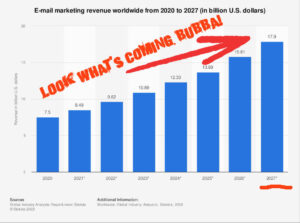
As you can see, email marketing worldwide will hit over $17 billion in revenue by 2027.
But if you are not convinced yet, here are a few more stats worth mentioning.
- Daily, there are 4 billion email users
- 77% of businesses saw an increase in their email engagement in 2022.
- Sales reps spend 21% of their workday on writing email messages
- 75% of sales emails get opened within the first hour
Now that you can see the benefits – let’s get into the meat of how to write killer sales emails that sell your goods and services.

Sales Emails Defined
Simply put, a sales email is a message from a business to prospects that sells products and services.
These messages can also strengthen relationships with customers and existing clients while introducing new services and products to them.
Sales emails are similar to direct mail campaigns because they mostly use words to generate revenue. And just like a direct mail campaign, successful sales emails are sent as a series.
What’s In It for You?
You could be one of two business owners.
You could be a business owner who uses email for their business but does not know how to write a sales email.
The other kind of business owner you could be one who is not using email marketing at all. If that’s the case, I highly recommend you learn as much as possible about this subject.
Email marketing isn’t complicated, but you should know the basics, and you will benefit enormously by learning how to write sales emails.
At the end of this post, I’m going to give you links to some excellent resources, so you can quickly become an expert at email marketing.
So, keep reading because learning how to write and use these messages will be fun and profitable.
Reasons You Need to Learn This
Let me give you more reasons to stick to this page like glue.
If you learn how to craft and use sales emails, you will become a valuable player.
You will be able to:
- Make profits selling your products and services
- Sell other people’s stuff
- Work for companies writing sales emails
- Freelance as a sales email copywriter
- Work for profitable companies as an email copywriter
- Make money with affiliate programs
- Create and sell information products and courses on how to write sales emails
As you can see, the scope of this one skill is deep.
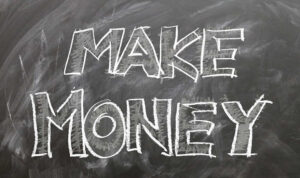
More Reasons to Learn This
Learning how to write sales emails is not hard, and if you put your rear into gear, you can learn this skill in a couple of weeks, and email marketing is still a dominant marketing channel.
Everyone can use copywriters who can create campaigns and sell products and services for them, so there is plenty of work in the freelance world.
Another positive aspect of using sales emails is you can produce them very quickly, and experienced copywriters can churn out a sales email in less than 20 minutes.
Of course, these are seasoned copywriters, but once you get used to writing sales emails, you will get faster.
Writing sales emails is easier for a copywriter than other projects because they are much shorter than a 2000-word blog post or a long-form direct mail piece.
Usually, sales emails run between 350 to 900 words, and the more concise you can write, the better because people have short attention spans when reading email messages, so being able to write short sales messages is better.
The Best Part About Writing Sales Emails
The best thing about writing sales emails is that it can be very lucrative.
When you are experienced and gain a good reputation, you can charge over $1,000 per email, and if you are starting, between $100 to $800 per email is what you can make.
But there is an aspect to writing these emails you may not have considered – rarely will you only write a single email piece because your prospect needs to see different and better offers.
Like a direct sales campaign, email sales letters do very when there are three or more messages, each with a better offer than the previous one. If you are writing an email sales campaign for someone else, you can charge $1,000 for a series of messages.
And if you remember what I told you earlier, if you have your own business, you can quickly and easily increase your revenue with email sales letters, especially if you have a list of prospects who have already told you to send them offers.
So, whether you are learning to write sales emails for your business or want to be a freelancer, you will crank up a money machine by digesting what I teach you here.
Now that you can see the benefits of writing sales emails – let’s go through the seven steps you’ll need to start making money.
So, get out your fork because here comes the meat!
Step 1: Learn to Write Engaging Subject Lines
The subject line in an email is possibly the most vital part because it is the first thing people see in their inboxes.
Just like headlines in advertisements or blog posts, if the subject line doesn’t grab the reader’s attention, it will wind up in the trash.
It is a single line of text your recipients will see when they scan their email messages.
When you consider the time and effort that goes into writing a sales email, the last thing you want is for your readers to ignore it.
So, you have got to get this right.
Here is an example of what I mean:

The Preheader is Important in Sales Emails Too
The preheader is the faded text right next to your subject line. It is a short summation of what readers can expect from your message.
Many top-dog email copywriters swear the preheader is very important.
If written correctly, it supports the subject line to get people to click on your email. So if the subject line is not compelling enough, the preheader will usually push the reader over the edge to read your sales email.
Note: The subject line and the preheader are not separate sections but partners that work together. Make sure your preheader text relates directly to your subject line in some way. If you are talking about apples in your subject line, don’t write about oranges in the preheader.
A Simple Way to Write Money-Making Subject Lines
As a copywriter, I love writing headlines, and I consider the process of creating them challenging and fun.
Crafting a subject line is the same as writing a headline for a blog post or a sales letter – and you can use this formula for those venues as well.
So here is a simple formula you can use:
B+C = I
To be more specific:
Benefit(s) plus Curiosity equals Interest
Pretty simple, right?
Let’s dissect a successful subject line to see how this works.
Here is a subject line from a business called Refinery29:
10 Bizarre Money Habits-Making Millennials Richer
So, if we use my simple formula above, we can start with the benefit(s)
“Making Millennials Richer”.
If you’re a millennial, you probably have a fire in your gut to make a lot of money, and the benefit is in the subject line.
If you look at the rest of the line, you’ll see the curiosity factor at work:
10 Bizarre Money Habits
The first thing that goes through your mind is, “I wonder what they are?”
Note: These headlines are not new ideas; similar ones were used in the 1800s.
One of the most successful copywriters to ever live was Gary Halbert in the 1970s.
Here is one of his headlines:
At Last – Scientists Discover New Way to Look Younger in Just 17-Days!
Benefit = Look Younger in 17 Days
Curiosity = Scientists Discover New Way
Now, if you were a woman flipping through a fashion magazine and saw the header on an ad like that, would you read the rest of the advertisement?
Of course, you would!
I recommend a formula like this because it has stood the test of time. Gary Halbert used this formula in his headlines, and he became rich.
So, if it worked for him, it would be foolish not to use it yourself.
(By the way, I used this formula for the subhead for this section: “A Simple Way to Write Money Making Subject Lines”.)
Valuable Points About Writing Subject Lines
Writing compelling, eye-catching subject lines is like an art; there will be days you’ll write an amazing one and other days not so good, but if you follow the advice in this guide, your open rates will be much better than if you just made something up.
Here are a few tips for writing them that you need to know.
Keep them as concise as possible.
If you blather too much about your subject, your subject line will read like a used car salesman pitch.
The last thing you want to do is have your message sent to the spam file, so you need to be as short and sweet as you can.
Brian Dean, founder of the SEO think tank, Backlinko, performed research on the subject of how long subject lines should be.
His work revealed that 41 characters are the longest a subject line should be, and subject lines that didn’t exceed 16 characters had much better open rates.
So, to break it down for you:
The maximum number: 41 characters
The best number: 16 characters
Here are some examples of successful subject lines and their character numbers:
Dollar Shave Club: Save money. Don’t leave the couch. (26 Characters)
Thrillist: “What They Eat in Prison” (19 Characters)
Jon Morrow: “I Want You Back” (12 Characters)
Chris Brogan: “We Don’t Do This Often – Take Advantage” (33 Characters)
TicTail: “Boom Chakalaka! Let’s get started.” (32 Characters)
Don’t be a spam monster.
The idea of writing great subject lines is to get people’s attention, and you don’t want your messages to remind your readers of a low-grade can of meat like Spam.
So here are some things you should not do in your subject lines.
Avoid using all capital letters.
Example: FREE GIFT – EBOOK – SHORT READ
Don’t use spammy words.
Examples: free, sex, XXX, Earn $, Order, etc.
Overt sales promotion should be at a minimum.
Examples:
LIMITED-TIME OFFER !! BUY 10 POSITIONS FOR ONLY $100 AND SAVED $100
$14 Books are Going Fast!
Buy, Buy, Buy!
Try not to use emojis too much.
Examples:

Make Sure You Are Always True
By the way, the FedEx email was false, and I did not have any packages on order, which brings me to another point:
Make sure you do not misrepresent yourself.
Everything you announce in your subject line must be true to your message.
Telling your readers that you have an important announcement and then trying to sell them a book is deceptive.
Whatever you announce in your email subject line must be delivered in the content of your message; never lie about the content because your readers will either ignore you or unsubscribe from your list.
If you are writing sales emails in a series, offer some information that will help your prospects. Information like this will give you professional status, and it will be easier to sell them your products and services.
Note: If you need a good resource on words that trigger spam filters, take a look at HubSpot’s post here: Email Spam Triggers
Use Words that Command Your Readers
Confidently telling people what to do is another way to get them to open your sales emails.
In copywriting terms, this is a call to action (CTA) and is a vital component of email copywriting.
Example: Join Us Tonight for Our Blogging Webinar
Notice it did not say, “Please, join us for our webinar tonight.”
Take charge and tell them what to do.
These subject lines are perfect for events you are hosting, and if you want your readers to look at a new product or course preview, go ahead and tell them to show up. Just make sure that your subject title matches the content of your email.
Use Excitement and Urgency to Grab Readers
A great way to get people to take action and read your sales emails is to stimulate them. In other words, tell them they must hurry, or there will be consequences.
I know this tactic works because many of the top bloggers and copywriters I subscribe to use them weekly.
Master copywriter Bob Bly uses email considerably to promote his business, and he uses urgency and excitement to promote his products.
Take a look at these subject lines he used over a week:
The Taking it Away Tactic
The uber-blogger, Jon Morrow, occasionally sends me an email telling me he will remove me from his list because I am not opening his email messages.
I got this subject line from him: Delete Your Blog
The preheader line said, “Soon, Mark, if you don’t want to receive any more emails…”
This kind of email uses a subtle psychological tactic called the taking it away mind trick.
It is the idea that the product or service is not for everyone, only those who are the right fit or, in this case, actively reading the messages.
Now, a word of caution.
You probably noticed that I said this was a SUBTLE psychological tactic.
Do not be overt with this idea and say, Ya better read this today, or I’ll kick your ass off my list.
No, that would not be a good idea.
Also, try not to overuse urgency and excitement in your messages. Be courteous and let your readers know that you genuinely care about them.
(If they don’t respond to your kindness, kick their asses off the list. Ha ha! – Just kidding!)
This kind of subject line is perfect for these events:
- Rolling out a new product or service
- A deadline like the end of a sale
- Saving money by taking action now
- The end of a product or service
- A rise in pricing
- There are only a few products left
If you want to create scarcity, then follow through.
Jon Morrow, who I mentioned earlier, sets dates for his offers, and if you are too late to the game, you miss out.
I have seen many countdown clocks, dates set, and other tactics to create a sense of urgency, and I ignore them because I know they are fake.
Ask Your Readers Critical Questions
If you remember earlier, I mentioned using a psychological tactic.
Mental methods of influence are crucial in copywriting, and you should use them in your email subject lines too.
One of the ways you can grab your reader’s eyes and engage them is by asking questions.
Take a look at some of these:
Are these 17 Entrepreneur Myths holding you back?
Still a Goal?
Elmo, Still Need Help?
Elmo, still on the Fence?
Want Us to Promote You on Instagram?
Did You Catch This?
How Can You Rewrite Your Brain for Efficiency?
How Do You Create ‘Stickiness’ with Your Customers?
These subject lines make people think, and if you can make them scratch their heads, it can be a good thing.
Note: If you ask a question in the subject line, make sure you answer the question in the email message.
Do not ask a question that is not the main subject of your email. Also, if your start a sentence or question – finish it in the email body.
Examples:
Hey Joe, I Was Just Wondering if…
When are you going to…?
Are you the one I told to…
These types of subject lines are considered to be spammy and will get your email chucked into the electronic trash.
Personalize Your Subject Lines with Segmentation
What else can you do to make messages more personal?
You can segment your subscribers into different categories.
Segmentation is a method of splitting customers and clients into different groups.
You can segregate groups on different factors like:
- geographic regions
- interests
- age
- birthdates
- anniversaries
- Purchase history
Most email platforms like Aweber, Mail Chimp, and Constant Contact have segmentation software built in, but your email platform can help you segment your subscribers.
For example, if you want to automatically capture your subscriber’s birthdates when they sign up to be on your email list, you can send them a birthday message. Doing this will make you stand out from competing businesses and make you a friend instead of a business.
Using segmentation tools takes time, but once you have written one of these email messages, you can send them out to all of your segmented readers.
Let Your Readers Know You are Sharing
One of the most popular marketing bloggers on the planet, Chris Brogan, has a compelling line, “The more I share, the richer I become.”
Many business owners will think giving away free information will kill their business, but it is the opposite. When you give away valuable information, you are proving you are an expert in your field.
So, if you can give away some free information in your sales emails and campaigns, tell them about it in your subject line.
- Examples:
Here’s the Template I Promised You
Preview of My Latest Webinar
Create Your Own Diet with These Steps
Whatever promises you make to your reader in the subject line, make sure you deliver them because your readers will ignore you and start unsubscribing from your list.
The Weird, Unexpected, and Intriguing Subject Line
Be careful when writing unusual subject lines because they can backfire if not used properly.
Once again, the words you use MUST RELATE TO THE MESSAGE YOU ARE SENDING.
Here are some that caught my attention:
That Pee Smell – This was so weird I had to read the email. It turns out it was a health message about a skin condition some people have that emits a weird smell.
The Underwear You Didn’t Know You Needed – A strange subject line that caught my attention was from an undergarment company that sold a cold-weather line of products.
Knock-knock! Who’s there? – I love knock-knock jokes, so I opened the email. Once again, make sure it relates to your message.
Stop Hiding – Here is a good subject line from a Chris Brogan email. The first line of the email message was Peekaboo Elmo, I see you… which appeared in the preheader text.
Frog Eye Salad – Taste of Home is a recipe company I love, so when this showed up, I just had to look at it. The name comes from using a pasta called, acini pepe pasta, with little dots on it like a frog’s eyes.
These kinds of lines are funny and intriguing, but they are relevant.
I Know, I Know, You Have Heard This Before
As you can recall, I have been reminding you to ensure your subject line reflects what is inside your email message, but I can’t emphasize this enough.
Every day, when I use the Google app on my cell phone, Google presents a news feed. Almost every news headline listed has an exaggeration of facts.
Just yesterday, I saw the headline, “Huge Chunk of the Sun Flies into Space…Scientists are Stunned.”
However, when I read the article, it turns out this is a regular occurrence with the sun, and the only reason the scientists were stunned was that they happened to catch a good picture of it happening.
I am now using a different Google app that does not have the newsfeed because I don’t want to see clickbait all the time.
So, here is the moral of the story:
You don’t want people on your mailing list to start ignoring you because you are playing games like this.
Now, let’s dive into the process of actually writing a sales email subject line.
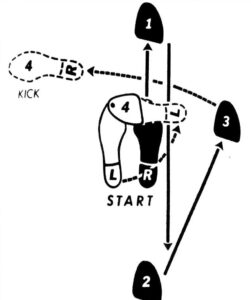
5 Steps to Writing Your Subject Lines
If you start cruising the Internet, you can find so many methods and templates on how to write sales copy that it’s staggering.
So, I will show you the way I write my subject lines.
But before you think I’m a genius for thinking up this method, I should tell you that I learned it from other copywriters.
As the good book says, “There is no new thing under the sun.”
And the good news for you is that the copywriters I learned from were highly successful.
So if you are wondering if they will work for you, no worries because these methods have been written and tested by the best in the business.
Step 1: Write Down the Purpose of Your Sales Email
Most bloggers and copywriters try to come up with a headline first.
Why?
Because the headline, or in this case, the subject line, is what your message will be about.
It is much easier to focus on a topic if your main idea is at the top of the page.
One of the main reasons for this is that it is too easy to veer off in a different direction when writing.
So, put your subject line at the top where you can see it.
In this case, my subject was copywriting secrets, and here is the subject line I eventually came up with:
REVEALED: Secrets of Millionaire Copywriters
Now I will show you how I came up with this subject line.
Step 2: Pull Up Your Resources on Your Project
First, I pulled out all of the information I could about the product I was promoting, and I also pulled up ads from competitors of similar products.
Once I organized my files, I went deeper.
I jumped on Amazon and a few other book dealers and looked up titles on similar subjects.
I copied and pasted the titles of books with the most sales and comments into a file, and then I read the comments and copied and pasted the ones I saw repeated several times into another file.
Now I had a better idea of what the most vital points were.
Step 3: Pull Up Subject Lines and Headline Files
Next, I pulled up my files of headlines and subject lines written by professional bloggers and copywriters and rapidly scanned them with my main subject in mind.
When a line catches my eye or strikes a chord, I’ll copy and put it into a Word document.
Step 4: Play with The Chosen Lines
After you have your chosen subject lines or headlines on a page, start playing with them.
One of the lines I liked was: Top Diet Secrets of Hollywood Models
I saw another subject line that said:
Revealed: Insider Stock Trading Strategies
So, I wrote out headlines for at least 20 minutes and came up with: REVEALED: Secrets of Millionaire Copywriters
Tip: Once you have written out a lot of subject lines, do not throw them out, keep them in a marked file for inspiration or use in another email sales letter or campaign.
Step 5: Pick the Subject Line You Like the Most
You will develop your own method of writing subject lines over time, but don’t spend a whole day trying to write the ultimate subject line.
I know of two ladies who are successful blog copywriters, and they will write out almost a hundred headlines before deciding on which one to use.
So if you want to Kubrick headlines for days on end, go for it.
In my opinion, if you write out too many, you could get confused and spend too much of your most precious resource (time) trying to get the ultimate subject line for your email.
Writing copy of any kind is like golfing. Some days you will have awesome games, and some days you can’t find the ball.
As you write out your subjects, you will find your mind drifting toward one or two of them. You may also hear angels singing and trumpets ringing in the firmament of copywriting heaven.
Sooner or later, you must make a choice and let the good times roll.
And I want to remind you again – make your subject line match the content inside of the email.
Test to See if Your Subject Lines Work
Some email marketers will check to see if their subject lines are magnetic enough to draw a crowd. One of the ways you can do this is by asking people you know what they think about it.
If you network with other copywriters online, getting critiques of your subject lines is easy. One of the places I like to hang out at is on the Warrior Forum, which is massive and is all about marketing online.
There is a section of the Warrior Forum where copywriters hang out, and if you get familiar with some of them, they are more than willing to help you.
Another place you can get opinions from copywriters is the Cult of Copy forum on Facebook.
Collin Theriot is the owner and a first-class copywriter, and writers of all levels hang out there, and you can get valuable advice from them.
In both places, I posted some of my writing to see what they thought of it and received helpful information.
However, I want to caution you.
If you get help from people online, you need to be polite and grateful and make sure you thank them and reach out to them now and then to let them know you are thinking about them.
A/B Split – A Great Way to Test
Split Testing (A/B Testing) is a way to see whether your subject lines are worthy of sending.
(A/B Testing is also a great way to measure if your entire sales email works.)
When you test, split your audience into two groups and send two versions of your subject line to each group. Performing this task will let you know which subject line is better than the other.
Once you have performed this test, your work is still not over because you need to keep the data you receive in a file for later reference. But if you have a site dedicated to one audience, it will be easier.
On the other hand, if you sell all kinds of products to a diverse market, you will need to split your groups even more.
I could write an entire blog post on this subject alone, but since we’re talking about how to write sales emails, I don’t want to stray too far off of our topic. If you want to learn more about split testing, here is a link to an excellent resource: How to Perform a Split Test.
Build Yourself a Subject Line Swipe File
I’ll bet you’re wondering why I have written so much about subject lines in sales emails. It’s simple – they are vital to getting your email read.
If the subject line sucks, so will your open rates, and not only that, but your conversion rates will suffer too, and you will get more unsubscribes.
If I were you, I would reread this section before I started writing emails so some of these ideas will be fresh in your mind.
That’s how important subject lines are, and if you are going to do any email marketing, you need to become an expert at writing them.
Before I conclude this rather large section on how to write subject lines, I want to give you one more important tip: you need to build yourself a subject line swipe file.
What is a swipe file?
It is the copywriting practice of collecting (swiping) ideas from other copywriters.
It is not stealing but getting ideas from other writers. The best copywriting teachers will tell you to swipe their most successful headlines and subject lines.
When another copywriter tells me my headline or copy is so good he had to swipe it, I am elated because it is an honor.
So, I am going to show you how I swipe subject lines.
Steps to Swiping Subject Lines
Step 1: Create a file and name it something like Subject Line Swipes.
Step 2: Create sub-folders inside your first folder with different niches you work in.
Example: if you are writing for a skateboarding niche, label a file skateboarding.
If you are marketing fishing lures, then create a sub-folder for that.
Here is an example of what I mean:
Subject Line Swipes –> Fishing Lures
Step 3: If you have to segment your folder further, then create a sub-sub-folder like this:
Subject Line Swipes -> Fishing Lures -> Bass Fishing
You can create as many folders as you need to keep your subject lines organized.
Step 4: Get an extra email account.
I usually use Gmail for all my regular email, but the other account is an email service named Yandex, and I use it to collect email files from businesses and gurus I like.
Of course, Yandex is free, but you have to sign up for it.
You need a separate account because you will be getting marketing and sales email messages from these businesses, and you do not want to wade through all of these messages in your regular one.
Below is a screenshot of my Yandex account: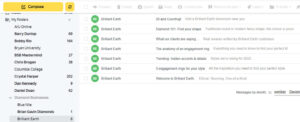
In this screenshot, you can see that I have the Brilliant Earth diamond company file selected with all of the subject lines I’ve put into that file on display.
This way, all I have to do is click on the file I want on the left-hand side, and I can scan the subject lines.
If you look at the names of the companies and entrepreneurs I have been collecting, they are heavyweights in their industries. For example, Dan Kennedy is one of the best marketers on the planet, and anything is company sends out is top-notch.
So, of course, I want to get onto his mailing list and receive his sales emails.
Sign Up For Great Sales Emails
Step 5: Go to the best sites in your niche and subscribe to their email lists. When you do this, you’ll get all kinds of email marketing messages to collect.
When you find subject lines you like, place them into a word processor file and save them to one of the folders. The reason why you should put them into files is so you can find them easily.
In a nutshell, this is how I create and organize swipe files for my projects.
Step 2: Learn the Different Kinds of Sales Emails
Before you start writing your first sales emails, you need to learn the different kinds there are. That’s right, not all sales emails are created equal – there are different kinds.
Here are four different kinds of sales emails you need to learn about:
- One-Shot Promotional
- Sales-Lead-Follow-Up Email Series
- Interest Building Email Series
- Relationship Preserving Series
Yes, there are more than four kinds of emails that you can use in your campaigns, but they are used to support your sales emails in different ways.
(I’ll show you what I mean later on.)
Let’s take a look at each one of the types of sales letters and what they do.
One-Shot Promotional Sales Emails
Many copywriters consider the One-Shot sales email the workhorse of email marketing because it is a single email sent to prospects that promote an offer.
However, it is not part of a series of emails but a stand-alone offer promoting a product or service.
You can also use this type of promotion to announce a free downloadable item like an eBook, white paper, or coupon that people can print up. So, it’s a single email that does all the selling work.
Here is an example of a one-shot promotional from best-selling author Jeff Goins:
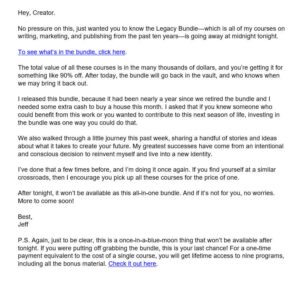
Usually, one-shot promotional emails are longer than the other kinds of emails you receive from entrepreneurs, but I picked this one because it is shorter.
With this single email, Jeff wants you to buy his Legacy Bundle course, and he is attempting to do it with just one email. He sold these courses separately in the past and now wants to sell them as a bundle in this single promo email.
The reason why most one-shot promotional emails are usually longer is that long copy sells better. I once got a sales letter copywriter and marketing guru Dan Kennedy, which was 34 pages long! So, if you ever write a one-shot promotional, remember that longer is better.
But going back to our example sales email, he is trying to get you to buy with this single email offer.
Notice the pressure Jeff applies in the first sentence – he says no pressure, but if you don’t buy the course today, the offer is off the table.
He is doing this because he has to sell you with this single email.
Another important thing is that he has two links to the product on the page, one at the top and one at the bottom.
As usual, he did not place any pricing on the page because he wants you to click on the links that will send you to a sales page or video where he will whet your appetite even further.
And guess what?
He still won’t tell you the price of his bundle until you go to the checkout page.
But I’m positive you have seen promotions like this before.
Writing one-shot promotional sales emails can be challenging because you’re only taking…One-shot. A single offer kind of email has to be very persuasive and use every trick in the book to get your reader to take action.
It is now time to discuss the second kind of sales email that is important…
The Sales-Lead-Follow-Up Email
If you remember previously, in these lessons, I told you that good copywriters usually send at least three sales letters to their direct mail prospect list.
The reason for this is simple: if people see your message at least three times, there is a greater chance that they will bite on what you have to offer.
And if your offer is better each time one of these emails gets sent, your chances of converting prospects into paying customers will skyrocket.
So, the sales-lead-follow-up email is just that – a series of sales emails (as many as you want to send) that follows up on leads you have amassed from your website or ads you have been running online.
[Graphic here outlining the process of collecting email addresses and a campaign?]
Places to Get Email Addresses From
Once again, let’s imagine you have a valuable eBook you’ve written for a niche industry, and you’re giving it away in exchange for prospects’ email addresses.
You can get email addresses from many places, whether you have an online business or a brick-and-mortar one.
Here is a list of places a business can get email leads:
- Tradeshows
- Business website
- Place of business
- Online advertisements
- Kiosk at businesses
- Pop up ads
- Collect business cards
- Direct mail call to action
This list could be longer, but you get the idea; you need to get into the habit of collecting email addresses.
Once you have delivered your freebie to your email list, you can send follow-up emails that may convert prospects into paying customers.
The best way to see this in action is to go to a popular website and sign up for whatever free thing they are offering you.
With a lot of businesses, they will offer you a free trial for a specified number of days. If you decide to take the next step and accept their free trial, you will receive emails asking how much you like their service or products while giving you a reason to purchase what they are putting out.
Here is an example of what I mean:
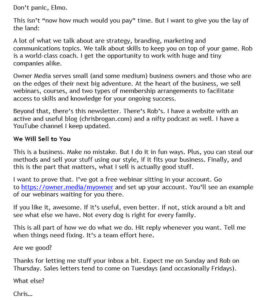
You Can Be Transparent
This email was from marketing giant Chris Brogan, which I received in my email inbox right after signing up for his free whatever. (Sorry, I can’t remember what it was.)
The funny part about this email is he is being very transparent about selling me stuff no matter what. Also, to keep you returning to his emails and website, Chris is giving away a couple of free webinars to keep you in his sphere of influence. (I guess that’s what I signed up for – Sheesh!)
Here’s another example of an email I received from real estate guru Ron LeGrand. You can see he’s thanking me for signing up, and then he tries to sell me something else for a buck.
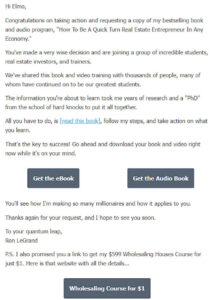
On Sale for Only $1
I know what you’re thinking.
You are thinking, “Gee, he’s only selling a course for a dollar? Either he’s selling lots of them – or he is not making much money.”
And you would be right on the second point because the object of this offer is not to make money. The idea of the $1 offer is to make you take the next step to an even bigger offer.
Once you’ve bought the Wholesaling Course, Mr. LeGrand will mention to you repeatedly throughout it about the next level thing you should buy.
It could be a video course, personal consultations with his staff of expert real estate experts, or something else. And I can guarantee the pricing will be significant.
But the bottom line is that these types of email campaigns work.
Here is the next email I received from Ron:
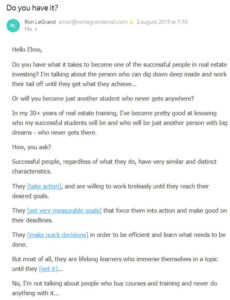
Notice that the links on this page that lead you to more expensive offers. I clicked on the “take action” link that took me to a Fast Track to Wealth course for $99.
So, you can see this kind of value follow-up emails can have for your business.
The Interest Building Sales Emails Series
The interest-building sales email series does what it says – it builds interest in a product or service you’re selling.
But how does this series do that?
Imagine that you have a large email following and you have already had several email campaigns. In this case, you have had some success with your one-shot-promo or your sales-lead-follow-up series, and now, you are hungry for more.
You want to introduce a new product or service to your email list and must educate them on what it is and does.
That’s where the interest-building sales email series comes in.
So you prepare a series of seven or eight email messages about your target product or service as if you were educating your readers rather than selling to them.
Bob Bly is one of the hardest-working copywriters on the planet. The output of this man is incredible, and I receive an email from him almost every day.
In the image below, Bob has a series of emails that build interest. He intersperses the series with emails he is sending about other topics, and then he sends you a connected series of messages about his information marketing course.

What These Checkmarks Mean
The red checkmarks are email messages that begin to inform you about how to make money selling information products. As you can see, Bob is warming you up with five or so messages about this targeted subject.
After the warm-up series, he overtly starts selling and tells you about his course named “Creating Information Products That Sell Online” (The green checkmarks).
Finally, he skillfully applies some pressure to get you to purchase (purple checkmarks) by reminding you that the deal he is offering will end soon.
This series is at least eleven email messages long, and the first one he sends you is about a webinar you can attend, in which he and another entrepreneur will talk about the course.
In each email there are two links to their webinar or sales page for you to click on.
So, the whole idea is to interest you in the business of selling information products while building your interest in the webinar and course.
You Can Sell While You Are Selling
One of the beautiful benefits of the interest-building series is that while you are drip-feeding your audience with informational emails, you can still sell other things to them.
Here’s an example of this tactic from an application designer named Miguel from Gumo.com:
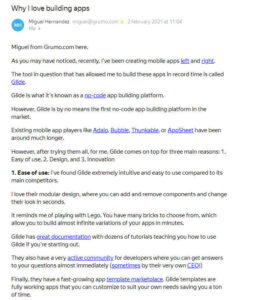
As you can see, there are links throughout his email, and they jump to products he makes affiliate commissions.
Warning: If you do this sort of thing too much, people will start thinking you are selling to them all the time and opt out of your list. Instead of selling in every email, try to teach them something valuable.
The Relationship Preserving Series of Sales Emails
I think the relationship-preserving sales emails are the most fun of all the different sales emails you can write.
You can talk about anything you like – within reason.
The whole idea behind this kind of sales email is to keep your subscribers in the loop, and you can do this in several ways:
- Announce a webinar and tell them what you’ll be discussing
- Make a podcast and supply a link with a description
- Send out a newsletter
- Share a valuable article relevant to your business
- Talk about something controversial or annoying
- Send out an email that will inspire people
- Talk about your pets
If you want to see an example of what I’m talking about, go onto James Altucher’s site and read some of his blog posts. Man, that guy talks about everything, even how to get into an argument with him.
And when you read posts or articles by James, it gives you ideas. Heck, if you like something he wrote, you could share it with your followers.
But the bottom line is, keep your subscribers thinking about you and your business by sending them valuable stuff.
It will make it so much easier to sell to them later.
Step 3: Defining Your Sales Emails Target Reader
For a long time, I got crappy advice on identifying my target audience.
Once I embraced the concept of understanding my target readers, selling to them has gotten a lot easier.
I’m pointing this out because you must know to whom you send your sales emails.
The Reasons Why You Must Know Your Target Audience
In a nutshell, the key reasons why you must know who your followers are:
1. Send them the right kind of message. It would be a bad idea to send messages to bird watchers about cryptocurrency. The more you understand what your readers want, the easier it will be to serve them.
2. The messages you send must address a problem or passion. What keeps them awake at night, motivates them, or makes them happy? Are your readers facing challenges that you can help them overcome?
3. Use the same language that they use. Did you know the word catch has a different meaning to skateboarders than it does to fishermen? There are more than 75 different slang words in a skateboarder’s vocabulary. Using terms, slang, and the language of your target market is paramount.
4. Your target market could have different behavior patterns. Does your target market celebrate certain holidays like Hanukkah or St. Paddy’s Day? Are they sensitive to issues like animal rights or the environment? People’s different lifestyles are key to addressing their needs while marketing products and services to them. Selling ice cream to a crowd of athletic types will probably be hard to do.
5. You need to consider your reader’s living space. Someone who lives in Vail, Colorado as a ski instructor is in a different environment than a postal worker in Detroit, Michigan. So, knowing what kind of an area they live in and work in is an advantage for you to know.
Dan Kennedy’s Method of Researching a Target Market
I got this story from the famous marketer and copywriter Dan Kennedy from a copywriting seminar in the 1980s. He told his students how he gets insider information on his target market.
Dan got hired to write a direct mail sales letter from a tarp company. The tarps were not camping or storage tarps – but the expensive kinds used on the backs of dump trucks. To write a high-converting sales letter, he had to know as much as possible about his target audience.
If you know anything about writing direct response copy, you probably already know how sensitive it can be, and because a small company can spend over $50,000 on a campaign, you must know who your buyers are.
So, how did Dan Kennedy get his insider information?
He found one of the companies that had already purchased the tarps and asked if he could hang out with them for a few days.
He visited the company offices to see where the decision-maker was and interviewed secretaries, employees, and managers. Dan also went to lunch with the drivers and rode in the trucks to see how they used the tarps.
He learned as much as he could about the people involved with the tarps and took copious notes.
When Dan finished gathering this information, he knew much about his target users who bought the tarps.
The message is clear: if big-time multimillionaire marketers and businesses do this much research on their core customers – it must be important!
In a bit, I’m going to show you how you can get this research completed online, so keep reading.
Before Writing Sales Emails – Build a Customer Avatar
When you start writing your sales emails, you should know who you are writing to, and the more you understand your target market, the better off you will be.
One way to get a You need to create a customer avatar or representation of your customers and clients because an image in your mind of the kind of person you are writing to is critical.
What is a customer avatar?
It is a portrait of your ideal customer or prospect based on the information you have researched and compiled. An avatar can be a list of demographics, like age, geographic location, interests, job, marriage status, etc.
The reason why a customer avatar is essential is that it will save you time and money. When you have a picture of who you are marketing to, you will not waste resources pursuing the wrong prospects.
If you go hunting elephants, you do not want to take a pellet gun.
Earlier, I mentioned showing you how to do your marketing research online, so keep reading because now I will show you how you can do it.
Facts You Need to Know Before Writing Sales Emails
Gathering facts and networking with people online can be fun, but don’t forget: getting information about your target market is your mission.
Here is a listing of some of the information you need to gather:
Demographics of Your Followers
Age
Gender
Location
Employment
Education
Family status
Income level
Hobbies and activities
You need to know as much as possible about who you are selling to.
The Psyche of Your Market
Their desires in life.
What keeps them up at night?
What kind of relationships do they have?
Are they creative or logic based?
Athletic or couch potato?
This list could go on and on, but you get the idea. The more detail you can get, the easier it will be to write to your prospects.
Use Social Media Sites
You can use social media sites to research your customer or client, but you’ll need to be smart about it. If you go on a site like Facebook, you can easily get sucked into reading posts and responding to your friend’s messages. While performing research, ensure you have your goals and an information sheet in front of you with the information that you want to gather.
Facebook Groups
If you use Facebook, you should join communities dedicated to your market space. You can make friends on those sites easily and ask the people you meet all kinds of questions.
My wife and I have an embroidery business, and I can get all kinds of information from people working in the industry by following leaders who are more than happy to share their trade secrets.
I joined several communities today related to the digitizing software I use.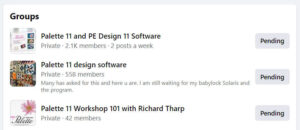
Quora
Man, I love this site for gathering information because Quora is a question-and-answer site that resembles Yahoo Answers. You can ask questions, and professionals are happy to answer them.
Professionals are willing to do this because it makes them look like leaders in their industry.
Over the years, I’ve learned how to digitize images for embroidery machines, I use Quora to ask questions about digitizing for embroidery, and I get all kinds of answers to my questions.
And guess what?
Usually, the people who help are selling courses, giving webinars, or selling products related to this industry
But you can log into Quora and ask questions about your target market, and people are more than willing to give you information about the kind of people you are researching.
Note: Don’t expect an answer immediately, and when someone responds, be very kind and thank them for helping you plus, they will respond if you ask them more questions.
Forums
I love the Warrior Forum because it is an online gathering place thousands of entrepreneurs, copywriters, marketers, and business people voice their opinions and give advice.
They share information on topics like starting a business, how to market online, copywriting, coding, and anything related to making money online.
And it is crowded with hordes of professionals who are more than willing to help.
So, you can easily find all kinds of information about your target market in a forum like this.
Do a google search to see if you can find an active and thriving forum related to the niche you are targeting.
But there are all kinds of forums online you can access.
Recently, I came up with the random idea of looking at electric bicycles, so I performed a Google search for a forum dedicated to them.
In two seconds, this is what I found:
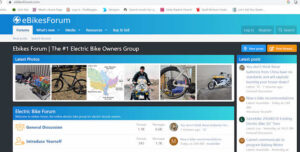
If you look up a forum for your topic and there are no results, then few people are interested in that market, and you will be better off targeting another niche.
LinkedIn is great for learning about people and networking with individuals involved in almost any business subject.
If you cruise LinkedIn enough, you will learn who the active users are in your target market and get demographic information by asking them questions about their businesses.
It is easy to figure out who the active users are by searching LinkedIn for members in the industry you are interested in.
Once you do that, you will see people who work for the company and who the followers are.
You can find out more about these individuals by looking at their profile pages on their pictures to go to their profile page, and once you are there, scroll down to where there is a heading that says, “Activity.”
LinkedIn will show you how active members are, and these are the people you want to network.
I know several copywriters on the site who talk about everything because they write about their businesses, their lives, and how they spend time with their families.
You can become a part of their network by requesting a connection, and once you do that, you can ask them all kinds of questions.
Use Book Search Engines
I use book search engines from a business like Barnes and Noble, eBay, and Amazon for different kinds of research.
Amazon is my favorite because the search function is very useful in getting information about niches and what people are looking for in life.
While researching your target market and trying to get information about what they want, you can do a book search.
All you have to do is click on the drop-down menu on the left of the search field and select the word – books.
Next, type in the kind of market or individuals you are researching.
For example, if you are writing sales emails about dog products, type in the word dog, and you will get a listing of the books about dogs, and Amazon will tell you which ones sell the most.
(Of course, you could look at the dog products too.)
But here is something that is fantastic about the Amazon website to copywriters.
There are comment sections under each product where people tell you what they liked or hated about their purchase. These observations are valuable because they show you exactly what you need to know about the people who bought them.
Here is one comment left by a consumer that I pulled from Amazon about a dog obedience book:
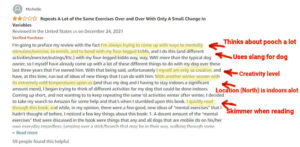
As you can see, I got five pieces of information about this dog lover from one section of their review.
Great Information – But Keep This in Mind
I realize this is only one person’s comments we are perusing, and it probably isn’t every dog lover’s persona.
But here’s the key to using Amazon’s comments to gather intel:
If you see the same feedback repeated, put it on file and keep it handy because it is significant to the consumers you are researching.
I like using this method of gathering information because I can get it done quickly.
Note: If you use this approach, look for the products with the most comments because gobs of them mean that the item was popular.
Access Your Current Customers and Clients
If you are already in business, this process should be painless because you already know your target market. Look at what kind of purchases customers and clients have made from you and any other information you have collected from them like:
- names
- addresses
- email messages
- purchases
- birthdays
- lifestyle notes
- feedback
Send Out Surveys
Most email platforms like Aweber and Mail Chimp have ways for you to collect information on your customers and clients. One of the ways they do this is by providing an easy way for you to create and send out surveys.
I use Mail Chimp a lot, and there is a form builder inside their platform which allows you to build your own survey.
It used to be you would have to use a separate service like Survey Monkey to build and send out surveys, but now almost all of the email service companies have them built in.
All you have to do is point, click, and add the questions you want your respondents to answer.
You probably won’t get more than a small percentage of individuals to respond, but any information will be valuable in creating your buyer avatar.
Look Up Statistics on Research Sites
Another excellent place to look for avatar information is from statistical sites like Statista.
However, most of the statistical sites are paid sites, and unless you want to fork over around $30 a month, you’ll have to pay to get most of the information you’ll need.
There are free statistical sites, but they are very time-consuming and display generalized demographics.
Step 4: Learn with Email Formulas
When you start writing sales emails, you should use a writing formula, and after using one, writing sales emails will become second nature to you.
So put these formulas into a file so you can pull them up and review them.
Formulas are nothing new to writers journalists use the who, what, where, and when formula all the time when they are starting.
On a basic level, a formula is a like a template that gives you the steps you need to take to complete your writing.
And it is the same way with almost any other kind of writing, like novels, screenplays, articles, and blog posts. So, using formulas or blueprints is what I used to learn how to write sales emails, and it can work for you too.
These communications are tested and used by the best in the business.
One other thing I need to tell you.
After you learn the basics, it will be OK for you to build and use your templates for writing these emails, and over time, you will develop your styles and techniques for writing them.
But these are the basics and proven money-makers that will definitely work for you.

The Fantastic Five Sales Emails Formulas
What I am going to show you are five blueprints you can use to write sales emails.
You should stick to using these five while you are learning because if you follow 50 other copywriters and their methods, it might confuse you.
So, while you learn – less is more; the fewer methods you try to follow, the more you will learn.
Here is a list of the “Fantastic Five Email Sales Formulas”:
- The basic one-shot promotional
- News flash promotional
- Content powered email
- Story piloted sales email
- The “What you don’t know” email
The Basic One-Shot Promotional Sales Email
The one-shot sales email does all the selling without the support of other emails, and the goal of writing this kind of email is to sell a product or service in one email.
Sometimes these emails are long, and other times, they are short.
Usually, they use a formula that consistently gets results, like the template I am giving you below.
Some copywriters call this the “Five Ps” template, and it follows the usual sales letter formula that has been around for ages.
Here is the template that will make it simple for you:
1. Prospect – Remember the avatar you created for your target prospects? They will be the person(s) you are writing to in your sales email, and you need to consider them on the front end.
2. Position – This is where you delve into needs, fears, wants, and desires they have, and this section agitates whatever is bugging them or makes them focus on cravings they have that need to be satisfied.
3. Provide – Now, you will start telling them how their problems or desires can be resolved or soothed, and you will talk about the benefits, features, and other details that explain how the product or service can fix their need.
4. Proof – The most popular way to prove that your product or service works are by using testimonials. So, if you do not have any testimonials, you can use case studies, press coverage, research studies, white papers, and visual representations.
5. Propel – This is the CTA (Call to Action) section, and you need to give them specific instructions on how to take the next step, like clicking a link, making a purchase, downloading a free report, or anything else that will move them in the direction you want them to go.
Example of a Basic Promotional Sales Email
To guarantee you have a clear picture of what a basic-promotional email looks like, here is one from Jon Morrow for a course he was selling:

As you can see, this is short and sweet, and it is not rocket-science.
The first thing you will notice is the subject line, and if you are on Jon Morrow’s email list, you are a writer or a wannabe writer.
In this case, the subject line is qualifying you, the prospect, as a writer.
The positioning in this sales email is stimulating your appetite for making good money writing blog posts, followed by the proof, and Jon has of the dozens of students who are making good money writing blog posts.
Note: If you make claims of any kind, make sure you can back them up because deceptive statements and lies get around the Internet fast.
In the blue linked text, you can see the propel section, and the sentence after it is a part of that process.
Now that you have seen this basic-promo sales email, do you think that you can write one yourself?
I am sure you can.

You Can Make It Longer
No, this is not one of those enhancement commercials you see on late-night TV, but you can make your solo promo email much longer.
I have seen very long solo promotional emails from copywriters like Dan Kennedy in my inbox, and many are over 800 words long.
As I mentioned, lengthy copy usually sells better, and Dan Kennedy is a master of long sales copy.
Note:
Get into the habit of watching commercials with 1-800 numbers because you can learn loads from them. They are scripted by professional copywriters who are experts at direct response copywriting, and if you see them on TV for months, you know they are winners.
While watching them, see if you can find the five Ps from this template/formula you just learned.
One-Shot Sales Email Exercise:
Here is what I want you to do next, go into your email and see if you can find a few solo-promo emails to dissect as we did above. (If you look in your spam folder, you should be able to find all kinds of sales promotional emails.)
See if you can find the five elements of prospect, position, provide, proof, and propel.
After you have picked your way through several of these sales emails, you will notice that they aren’t always in the same order.
Sometimes the proof part will come before the positioning, and other times it can come after the propel – call to action section. It all depends on how you want to write your basic one-shot promotional.
The News Flash Promotional
The news flash promotional types of sales emails are quick messages you can send out as a reminder.
Let’s say, for example, you sent out a series of email messages about a course you are launching, and you want to remind your readers that they can sign up today for a free trial. All you have to do is send one of these short email messages to your list.
The template for this is:
If – Talk about an event or condition you want your reader to know.
Then – Tell them about your event or solution they can use or attend.
But – This gives the option to use that information. If your reader has already bought into your solution or attended an event, remind them there is an alternative.
Here is what a news flash promo looks like:
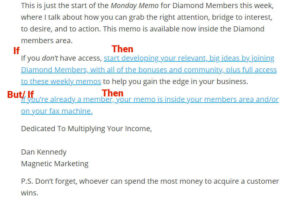
As you can see, there is no set pattern to this template.
It could be:
If –>Then–>But–>If–>Then–>But
Or
If –>But –>Then
Or
If –>But–> If –>Then
Or any other combination that works.
In the email above, Dan Kennedy has two different routes; if you aren’t a member, you should join his group, but if you are already a member, go there to get your memo.
Here is another example from the serial entrepreneur James Altucher:
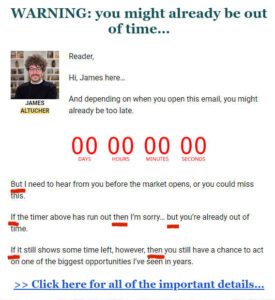
As I said, there isn’t a set formula for this If –>Then –>But stuff, but it works for promotional messages.
Content Powered Sales Emails
Crafting content-powered messages can be very similar to writing blog posts because you are handing your readers the valuable information they can use, proving you have expertise in this area.
Content-powered messages can be beneficial for people who are in the service industry.
For example, if you are a bug exterminator, you can write about the different kinds of bugs that invade a person’s home and what the solutions are (usually your service).
You could also write about the damage these critters can do while causing health problems for homeowners.
If you are selling products, you can do the same thing.
If you sell vacuum cleaners, you could write about health problems people experience with dust and how different attachments on your vacuum can help alleviate these conditions.
Any business can use this type of content-driven email, so here is the formula you can use to write them:
Problem/Goal – What desires or problems do your prospects have?
Insight – This is something you know about that can help your readers with their problem/goal.
Details – This is information you can share that gives your readers a better understanding of their problem/goal. Usually, you can give them tips, opinions, or advice.
Call to Action – Tell them to take action – click a link, download a file, keep looking for more email messages, etc.
Once again, the best way to see this in action is to give you an example of how a content-driven email works.
Here is an excellent example of how to write a content-driven email:
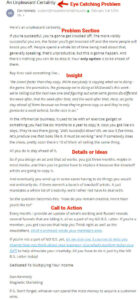
Breakdown of a Content-Driven Email
This is the way a sales letter or a blog post gets scripted. First, there is an eye-catching subject line drawing you into the email.
Next, you have a problem/agitation section that details why you have a problem and how it will get worse. This letter hammers the idea that if you are successful at a particular business, you can get knocked off by your competition.
After that, there is an insight section where this topic is verified by quoting hamburger giant Ray Kroc.
After that insight, Dan Kennedy irritates that further by telling you that because of the information highway, your problem is bigger than ever.
Once you are convinced that this is a problem, you start getting details on why this problem is crucial and what will happen to your business if you don’t take action.
In this email, you get the solution or an idea about what you can do to fix the problem, and the rest of the message will lead you to a call to action.
As I have mentioned several times, this is the same format found in sales letters, blog posts, and TV advertisements.
Note: If it makes it easier, you can use the copywriting acronym AIDA, which stands for: Attention – Interest – Desire – Action
The Story Plotted Sales Email
Everyone loves stories, and if you know how to write them, you can use them in your sales emails.
I’m not talking about writing a novel but a sales email that is story based.
Here’s a story-based sales email I wrote a year or two ago:
How My Friend Is Dumping Her Dead-End Gig to be a Copywriter
Hey Joe,
I thought I’d tell you about a friend of mine named Lois.
Lois works at the local grocery store where I met her.
Even though she manages the bakery, she is still considered part-time. (Under 40 hours a week.)
Like many companies today, only a handful of people are considered full-time – the rest are out of luck.
Not only that, but the company had a floating schedule that changed a lot, so she never knew when she would be off. Most of the time, Lois would have to work random days and nights.
Of course, the pay was minimal, and she had to do odd jobs to keep her head above water.
One day, I bumped into her at the bakery, and we started chatting.
Lois was stressed out because of her schedule and finances.
I knew she was a hard worker, so I asked if she had ever considered upping her game.
She had no idea what I meant.
“You know, like acquiring a skill, learning a new trade, making yourself more valuable so you can earn more money,” I replied.
The biggest problem was that Lois was middle-aged and had no idea what she would learn.
I told her that I had learned copywriting.
“What’s that?” She asked.
I told her that copywriting is everywhere: blog posts, advertisements, billboards, email messages, and just about every kind of business writing there is.
She was surprised at the scope of copywriting and never thought about it as a business or job.
So, I told her about an online copywriting school that she should check out.
Usually, I don’t promote this resource because it is not for everyone. But Lois was in a dilemma – I just had to tell her about it.
A few weeks later, I was at the store and bumped into her again.
I had almost forgotten about mentioning the copywriting school.
Yet, Lois had a different experience.
She told me she could not get the copywriting idea out of her head.
Once she went to the website, she read all the articles.
To cut a long story short, Lois is getting an upgrade in her life.
In two more weeks, she is telling her boss that she is quitting her part-time status job. Yeah, it took Lois some work to get to this point, but now she has an income that will replace it.
She also told me she was on track with the school’s 4-step program for earning six figures.
(And to think she learned about this by mere happenstance – just like you are right now!)
Because when you finish this rigorous course, you will be able to:
- Make solid money
- Live life on your terms
- Work from any location you want
- Become a recognized leader
- Benefit from related copywriting opportunities
- Choose your hours
- Work as little or as much as you like
- Take vacations
- Stop worrying about paying bills
- Buy luxuries you have always dreamed of
But don’t take my word for any of this.
Do what Lois did and do your research to see if what I am telling you is a fact.
Click this link right this second and check out this incredible offer to learn copywriting and start making solid money: Six Figure Copywriting School
Here’s to today – because it is always the best day to get started!
– Elmo
Analyzing the Basic Story Format
So that is a basic story plotted sales email, and they can take many forms. Usually, the story follows a basic pattern that almost all tales follow, and it looks something like this:
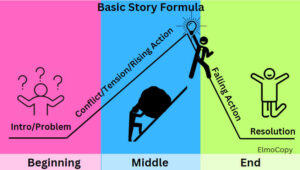
The exposition is the setup of the story, and it tells you about Lois and how her life sucks – she is in a dead-end job that she hates with no apparent way out.
The conflict she is having is agitated by my description of her situation. This section doesn’t have to be as short as the story I wrote, but you can make these sections as long or as brief as you desire.
The rising action is where I begin to tell Lois about the opportunity of becoming a copywriter and how I have to explain to her that she needs to explore the possibility of learning the art of writing copy.
The climax is when Lois tells me she is taking action and learning copywriting by taking the course I prescribed and how her life was better.
The falling action is how everything is now a bed of roses, and Lois is quitting her job.
Finally, the resolution is the call to action, telling you how you can do the same thing as Lois by taking the class I told you about in the story.
There are all kinds of story formats, but as I said earlier, this one is the most basic.
I am sure you’ve seen this format in other stories, so here are a few of them to refresh your memory:
- Cinderella
- Rocky Star
- Wars
- Horatio Hornblower
- Wizard of Oz
The beauty of email story writing is you don’t have to write a complicated, and it does not have to be lengthy, and story-based sales emails have to be long enough to get your point across.

Your Story Email Can Follow Different Paths
You don’t have to use a personal story for this message to work or insert yourself into each one.
Your story email could also be:
- A question from a client or customer
- Stories from your customers
- Questions someone has asked you
- Examples of how things work
- A relevant news story
For example, I received a sales email from a gold trading company, and the message was a news report on how the U.S. government is inflating our currency by raising the debt ceiling.
The report detailed the financial chaos about to occur and how horrible it could be once the world has to take action, and then it cited other news reports and white papers to back up its claims.
Then the email detailed seven things you could do to prepare for this calamity, including buying gold.
(Isn’t it funny how gold companies are willing to trade gold for worthless currency?)
So, there you have a story arc:
Problem/Situation -> Agitation/Fear -> Details/Reports -> Solution à Take -> Action/Resolution
So, you don’t have to follow the same format every time, and as you continue writing, you will develop and learn different ways to write story-driven sales emails.
What You Don’t Know – Sales Email
The last type of email I want to show you is the “What You Don’t Know” kind of sales email. Here are the basics of these types of sales emails:
“You already know this, this, this, and this, but what you may not know is…”
I repeated the word “this” several times, but you can point out as many facts as you need to, and they can be one point or ten, but it depends on what your audience needs to know.
To break it down for you, here are a few blurbs from these kinds of emails:
“You already know that I lost millions of dollars investing in real estate, what you may not know is…”
Or
“You may have seen the Chinese spy balloons floating over your town, but what you don’t know is…”
Or
“You already know that Amazon is a great place to buy stuff, but what you don’t know is…”
This format is simple, and after you get used to writing these kinds of messages, you will find different ways to write them.
Note: One of the beautiful things about writing sales emails like these is they don’t get used very much. I combed through thousands of emails researching this topic and could only find a handful of them in my loaded inbox.
Does this mean that they aren’t worth using?
No, this means that they are under-used, and it will allow you to stand out from the crowd.
Variations on the “What You Don’t Know” Sales Emails
I’ve seen some variations of this kind of email message, and here are a few of them:
Dear Elmo,
You may not have known that we recently offered a 25% off sale on our latest video course, but we will tell you now is you can still take advantage of this stunning offer.
Dear Elmo,
You’re probably aware that inflation is eating at your savings daily, but we’re sure you didn’t know this…
Elmo,
You knew we have a world-class blogging course. You know that Joseph Blow is the greatest blogger on the planet, and you also know we have expanded the course to include free consultations. But…Are you aware of what is holding you back?
Let us tell you…
Those were just a few examples of how flexible and creative you can get with this type of sales email.
You Can Expand These Formulas
If you learn these basic five formulas and play with them to make them your own, you’ll never run out of ideas.
Next, create a swipe file of all the best sales emails you collect.
Analyze them and segregate them into different categories so you can review them for ideas and inspiration.
When you dissect them, you will learn all sorts of phrases and methods you can use to make your sales emails convert at higher rates than your competitors.
Step 5: Start Writing Your Sales Emails
We are at the last step in your journey to learning how to write sales emails.
I will give you the last formula to use and then show you how to sit down and start writing.
If all the information on writing sales emails seems confusing, keep reading because I will make it really simple for you so you can get started today.
Review of the Most Basic Sales Email Formula
Do you remember earlier when I mentioned this formula – AIDA?
Let’s review it for a second:
A = Attention
I = Interest
D = Desire
A = Action
So, this is the most basic copywriting formula, and most copywriters start out by learning this one.
Let me show you another good email from Jon Morrow that I have in my files so you can see the pieces of the AIDA formula in action.
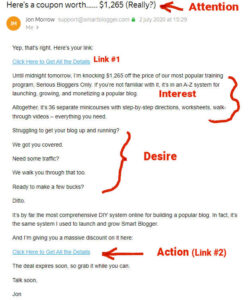
Attention – Grab Your Readers Eyes
The first thing you see is the headline/subject line that grabs your attention, and many copywriters will write another headline at the beginning of their email message, but that’s not necessary.
When building my email swipe files, I collect most of them from the most successful online marketers.
I hardly ever see another headline because of the subject line, because the subject line appears at the top of the email, anyway.
So, why have another one?
It is a matter of personal preference, and if you think you need another headline, go ahead and use it.
Interest – Something Great is Happening!
Now that you have their attention, you have got to keep it focused on your email, and in this case, Jon has a course that is such a good deal he has to tell you about it.
And since you are on his mailing list, you are probably a blogger struggling to make money, and this is the solution to your problems.
Desire – Tell Them the Biggest Benefits
Once your readers know your subject, you can fan the flames of desire by telling them the benefits they will receive.
I could have also labeled the features of the course, like the 36 mini-courses and all the other stuff Jon Morrow was offering, in the Desire section.
Features and benefits can blend together in sales copy, but your focus should be on the benefits and how they will better your reader’s life.
Action – Do This Now
The last section of the AIDA formula is the call to action (CTA), and Jon Morrow tells you to, Click Here to Get All the Details.
It is always a good idea to tell your readers exactly what to do and not to leave anything to chance, so if you have a free report, instruct your readers to click the link to download the free report.
Let’s Not Forget the Links!
If you look back at this email again, you’ll see two links that go to the same destination.
The two links are not a mistake, and most email marketers know to give prospects two opportunities to check out the offer. So, you want one link at the beginning of the email and one at the end.
If you are merely writing a relationship-maintaining email, then you probably won’t need to have any links at all, because you are touching bases with your subscribers.
However, if you want to add value to any email, include a link to an article you read or a download that is valuable to your audience.
Can You Write an Email Like This?
I think I have given you enough information in this dissertation, but here is a loaded question: Do you believe you can write an email like the ones I’ve shown you?
(Standing on top of your computer chair, you shout to the world, “Yes, I can!”)
Great, then my work here is done.
But wait!
Let me give you a bonus section that will help you get started.

Bonus Section: How to Start Writing Sales Emails Now
Friend, you must create a schedule for yourself and keep it – otherwise, your efforts will be doomed.
Here is a true story that may help you.
In junior high school, I wanted to learn how to play the trombone, and I was passionate about it.
My parents never had to tell me to practice.
I would go to school early and practice before school, and at lunch, I was in the band room practicing, and nightly I practiced for four or five hours learning how to do jazz improvisation.
My dad was a janitor, and he would beat on the door to my bedroom and yell, “Hey, can ya knock it off? I’ve gotta go to work tomorrow, and the neighbors are complaining!”
I was trombone crazy, and the fruits of my efforts paid off.
When I graduated from high school, I took an audition to join the U.S. Army Band program and wound up in the headquarters band in Europe playing jazz.
My point is if you are going to get good at anything, you must have a routine you follow.
I’m not saying you must be a committed addict like I was, but it would not hurt you.
I get up at five or six AM every day and get about three hours of writing in, and every chance I get, I’m writing.
At this moment, it is 7:30 PM, and I have been writing for almost two hours.
Some days I can fit in a six-hour day on writing alone. I’ll take my Dell laptop with me frequently, and if I know that I will have an hour or two where I can sit someplace and write, I’ll try to fit it in.
So, here are a few ideas you can use to get started writing.

Pre-Action: Stuff to Do on the Front End
Without going into a great deal of detail, are some ideas of what you should do before you start writing your sales emails.
First, gather as much information on your subject as possible, and read interviews, books, manuals, and blog posts.
The famous movie director, Stanley Kubrick, would research his subjects for years before filming a movie.
Of course, copywriters and entrepreneurs don’t have the luxury of time to spend on an email campaign, but you need to know your subject before you start writing.
I know one copywriter who collects at least ten blog posts on his subject and reads them all before he starts writing one.
he message is clear – know your subject first.
Action #1: Set Up the Night Before
Preparation is essential to success, so I like to prepare things the night before.
I write on a laptop, and I will put it into sleep mode the night before so that when I sit down in the morning, so all I have to do is shake the mouse (my, that reads a little weird) so I can start immediately.
I turn off all social media, email messages, and videos so that I will not have any distractions, and I read my word processor with the document I will be working on when I get up.
So, this is the first thing I want to see when I sit down.
Next, I have resources I place near my computer with eBooks and swipe files where I can easily find them on my hard drive.
I also prep my breakfast, coffee, and water too.
Action #2: Do Not Just Sit Down
As soon as my feet hit the floor at 6 AM, I head to the kitchen, grab my water bottle and let Waggles, our dog, outside to do her thing.
I also start the coffee, eat a banana and drink some water.
Eating and drinking are significant because I do not want to be hungry and dehydrated while trying to concentrate on my writing, and that would be another set of distractions I want out of the way while writing.
Once I let Waggles back in and throw her a morning chicken strip, I sit down with my coffee and start writing.
Yep, getting started is that simple.
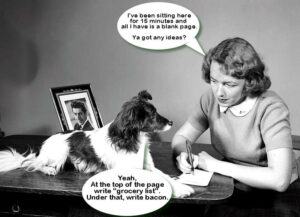
Action #3: Start Writing
One of the advantages of studying your subject matter is that once you have digested as much as you can on the subject, it will be easy to get started.
If you need to make a brief outline for your sales emails, then you should do it, and it should not take you very long to write one unless you are doing an informative, long-form post.
Since many of your sales emails will not be long-winded, you should be able to knock out a series of them.
Of course, with more practice and writing, the process will become easier – and the writing flow will come to you much more quickly.
If you find that you get tired of writing after some time, set yourself a timer.
One way to do this is to use the Pomodoro technique.
The Pomodoro technique is a simple time management system that you can use to keep your brain and body running at an optimum while writing.
Here are the steps:
- First, set a timer for 25 minutes and stay focused on your work, and do not deviate.
- After 25 minutes, take a 5-minute break.
- Repeat the first two steps four times.
- After the fourth time, take a fifteen to thirty-minute break.
And that is the Pomodoro technique.
You will find that a 25-minute session goes very fast, but after completing four 30-minute sessions, you will not feel so burned out and be ready to do more work.
Conclusion
I realize this was a long piece of reading, but I wanted to make you could write a sales email as soon as possible, and the faster you begin to use sales emails in your business, the sooner you will be able to make money.
Yes, you can use what I’ve taught you here to promote your business and products, but you can write for others too.
Once you get good at writing for yourself, people will pay you to write for their businesses, and you can charge good money.
The average salary for an email copywriter is $61,000, according to ZipRecruiter, and the work is plentiful because everyone needs to use email to promote their businesses.
If you liked this post, please leave a comment – it would make my day.
Want to REALLY make my day? Hit some of the social media buttons below and share them.
Now, start writing!
